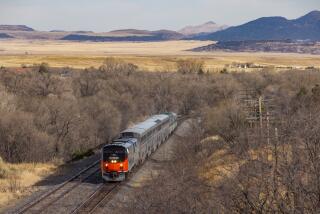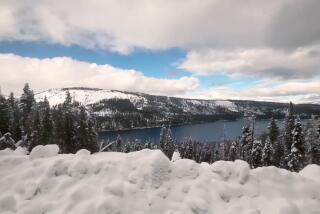THE MOUNTAINS
THE MOUNTAINS
The tracks, smoother now, begin to climb. It grows cooler. The train passes 60-foot stalks of bamboo. It rolls through putrid white smoke from a Kimberly-Clark factory that turns sugar cane pulp into Kleenex and toilet paper.
In Orizaba, the train changes crews. Enrique asks a man standing near the tracks, “Can you give me one peso to buy some food?” The man inquires about his scars. They are from a beating little more than a week ago on top of a train. He gives Enrique 15 pesos, about $1.50.
Enrique runs to buy soda and cheese to go with his bread. He looks north and sees snow-covered Pico de Orizaba, the highest summit in Mexico. Now it will turn icy cold, especially at night, much different from the steamy lowlands. Enrique begs two sweaters. Before the train pulls out, he runs from car to car, looking into the hollows at the ends of the hoppers, where riders occasionally discard clothing. In one, he finds a blanket.
As the train starts, Enrique shares his cheese, soda and rolls with two other boys, also headed for the United States. One is 13. The other is 17. Silently, Enrique thanks the food throwers again for the bread.
He relishes the camaraderie: how riders take care of one another, pass along what they know, divide what they have. Camaraderie often means survival. “I could get to the north faster alone,” he figures, “but I might not make it.”
The mountains close in. Enrique invites the two boys to share his blanket. Together they will be warmer. The three jam themselves between a grate and an opening on top of a hopper. Enrique stuffs rags under his head for a pillow. The car sways, and its wheels click-clack quietly. They sleep.
 The train enters a tunnel, the first of 32 in the Cumbres de Acultzingo, or the Peaks of Acultzingo. Outside is bright sun. Inside is darkness so black that riders cannot see their hands. They shout, “¡Ay! ¡Ay! ¡Ay! ¡Ay! ¡Ay!” and listen for the echo. Enrique and his friends sleep on. Back in the daylight, the train hugs a hillside. Below, a valley is filled with fields of corn, radishes and lettuce, each a different hue of green.
The train enters a tunnel, the first of 32 in the Cumbres de Acultzingo, or the Peaks of Acultzingo. Outside is bright sun. Inside is darkness so black that riders cannot see their hands. They shout, “¡Ay! ¡Ay! ¡Ay! ¡Ay! ¡Ay!” and listen for the echo. Enrique and his friends sleep on. Back in the daylight, the train hugs a hillside. Below, a valley is filled with fields of corn, radishes and lettuce, each a different hue of green.
El Mexicano is the longest tunnel. For eight minutes, the train vanishes inside. Black diesel smoke hugs the tops of the cars.  It burns the lungs and stings the eyes. Enrique’s eyes are closed, but his face and arms turn gray. His nose runs black soot. Engineers fear El Mexicano. If a locomotive overheats, they must stop. Riders spring for the arched exits, gasping for clean air.
It burns the lungs and stings the eyes. Enrique’s eyes are closed, but his face and arms turn gray. His nose runs black soot. Engineers fear El Mexicano. If a locomotive overheats, they must stop. Riders spring for the arched exits, gasping for clean air.
Back outside, ice forms on the cars. Riders ache and shiver. Their lips crack, and their eyes grow dull. They hug themselves. They pull their shirts over their mouths to warm themselves with their breath. When the train slows, they jog alongside to ward off the cold. As night falls, some of the older immigrants drink whiskey. Too much and they tumble off. Others gather old clothing and trash and build fires on the ledges over the wheels of the hoppers. Some stand in the warm plumes of diesel smoke.
 At dawn, the tracks straighten and level out. At 1½ miles above sea level, the train accelerates to 35 mph. Enrique awakens. He sees cultivated cactus on both sides. Directly in front rise two huge pyramids, the Aztec metropolis of Teotihuacan.
At dawn, the tracks straighten and level out. At 1½ miles above sea level, the train accelerates to 35 mph. Enrique awakens. He sees cultivated cactus on both sides. Directly in front rise two huge pyramids, the Aztec metropolis of Teotihuacan.
Then he sees switches and semaphores. Housing developments. A billboard for Paradise Spa. A sewage ditch. Taxis.
The train slows for the station at Lecheria. Enrique gets ready to run.
He is in Mexico City.
| [ Return to Top ] | NEXT: SUSPICION |
More to Read
Sign up for The Wild
We’ll help you find the best places to hike, bike and run, as well as the perfect silent spots for meditation and yoga.
You may occasionally receive promotional content from the Los Angeles Times.






